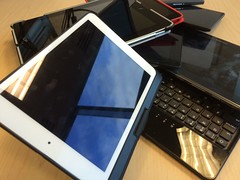22 BYOD Activities That Work With Smartphones
Below is a list of middle school and high school activities that you can use in your classroom that work well with smartphone technology.
Basic research
- Internet scavenger hunt: Students use basic Google searches to find information.
“Name 2 US presidents who were unmarried while in office.” - Givens in word problems: Students look up missing parameters in word problems.
“Calculate the momentum of a baseball thrown at the speed of the world’s fastest pitch.” - Fact checking: During class, students can be responsible for finding/verifying current events topics.
“On April 14-15, there will be a total lunar eclipse. How late should you stay up if you want to see it?” - Units conversions: Students can convert nearly any units of measurement or currency just by typing it into the Google search bar.
“How many acres of sod are needed to cover a new football field?” - Calculator: For non-testing situations, the built-in or app calculators will do fine. You can also download graphing calculator apps.
“Use your calculator to solve the following problems…”
Document Creation/Editing
- Quick writing: Students can create and edit any Google Document from a smartphone
“For the next 5 minutes, do a quick-write reflection on last night’s reading.” - Peer reviewing: Students can easily read and comment within shared docs as well.
“Share your essay with your partner, read each others’ work, and give feedback on the quality of the thesis statement.” - Data collection: Students in a lab can record class results in a shared Spreadsheet
“Please record your group’s value for density in the chart so we can determine the class average.” - Shared notes: Students pair up and take class notes on a shared document. This allows students to share the note-taking load, and to benefit from others’ perspectives.
“During my presentation, pair up with a partner and take notes in a shared document.” - Brainstorming: Students can work in a document shared with the whole class for brainstorming activities.
“In the shared document, please write three words that you think best describe the main character’s personality.” - Spreadsheet work: Students can enter lists of data, and perform bulk calculations on them.
“For this lab, measure the length of all 20 objects, and convert their lengths to meters.”
Assessments
- Video project: Students can shoot and edit video on any smartphone
“Create a video tutorial of your lab procedure.” - Forms quizzes: Students can take quick formative assessment quizzes that are created as Forms. “Take the short quiz on the ‘sohcahtoa’ rule we discussed in class today.”
Communication
- Email: Any smartphone can access Gmail. This is a great way to send links to documents or websites to every student.
“Open your email and follow the link to the Washington Post article about the upcoming election." - Backchannel: Use text messaging, Twitter, or a Google doc to create a “background” conversation about a lesson, reading, video, or other “foreground” activity.
“As you watch the video, look for examples of symbolism. When you see an example, mention it in the Twitter feed at #MyClassVideoBackchannel.” - Exit tickets: Students can fill out a simple Google Form as a class exit ticket
“For the last five minutes, fill in the exit ticket Form and reflect on today’s lesson.” - Online grades: Allow (no, encourage) students to check their grades using your school’s online grading system.
“While I set up this activity, please use this time to check your term grades so far, to make sure you have turned in all of your journal entries.”
Productivity
- Reminders: Have students set reminders to themselves to break up large assignments
“Everyone set a reminder to work on your rough drafts on Thursday afternoon, so we can review them in class on Friday.” - Calendar events: Students record calendar events for projects or assessments.
“Our unit test will be on Wednesday. Everyone please put that into your calendar, and set a reminder for Tuesday night so you remember to study.” - Note-taking: Students can take notes in the phone’s built-in note app, or with Evernote or OneNote (both are now free). "Use your favorite note-taking app to keep track of today's main themes."
- Whiteboard: Let students take photos of your whiteboard as part of their notetaking.
“Now that our brainstorming session is over, take a picture of the whiteboard so you can use some of the ideas in your essay.”
Hopefully you can find a lesson or two in the list above to inspire your own lesson ideas. If your students bring those smartphones to class, put them to good use!




Actually, I had in mind that the smartphone itself is the accommodation for students who don't bring laptops/tablets to a BYOD class. However, many of these activities can be done as "share-your-phone-with-a-partner" activities in a pinch.
ReplyDelete